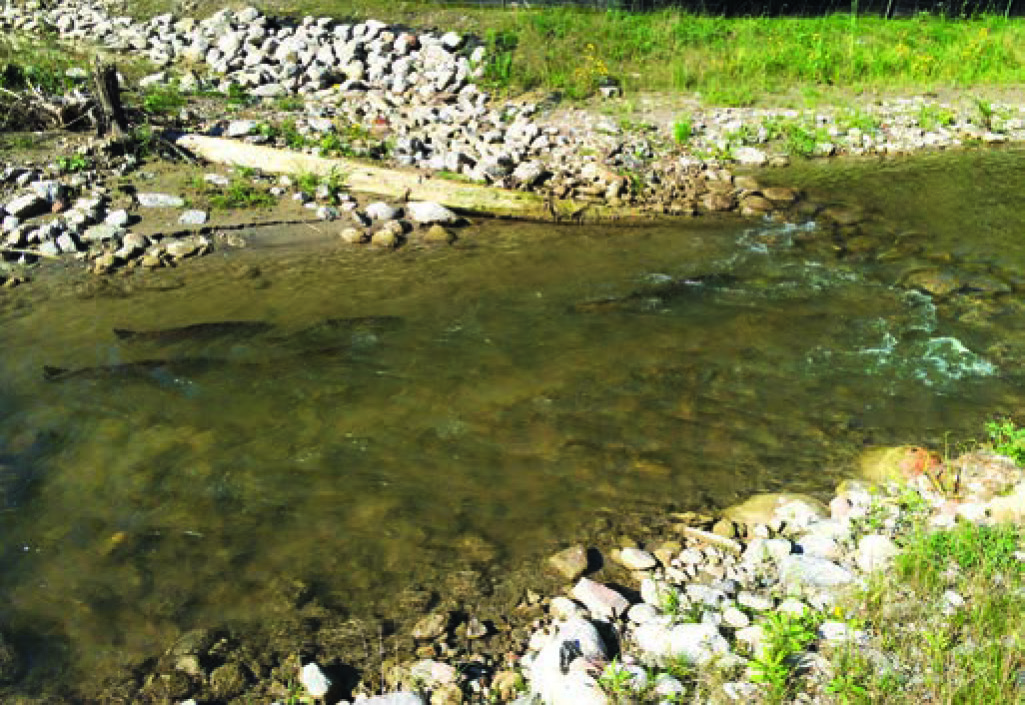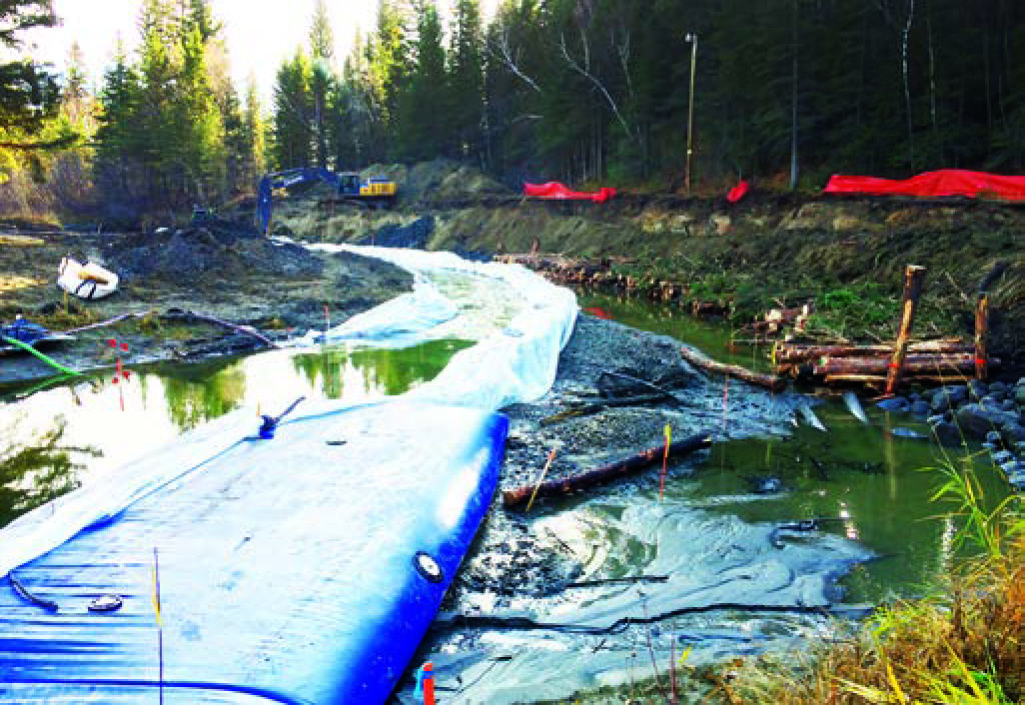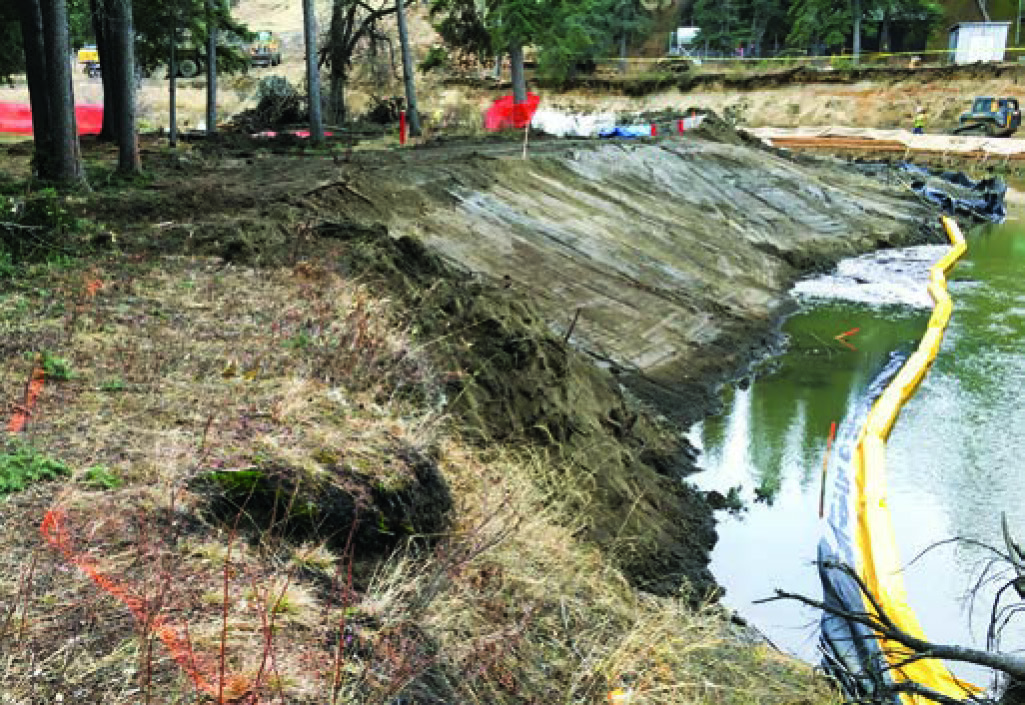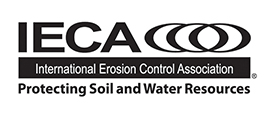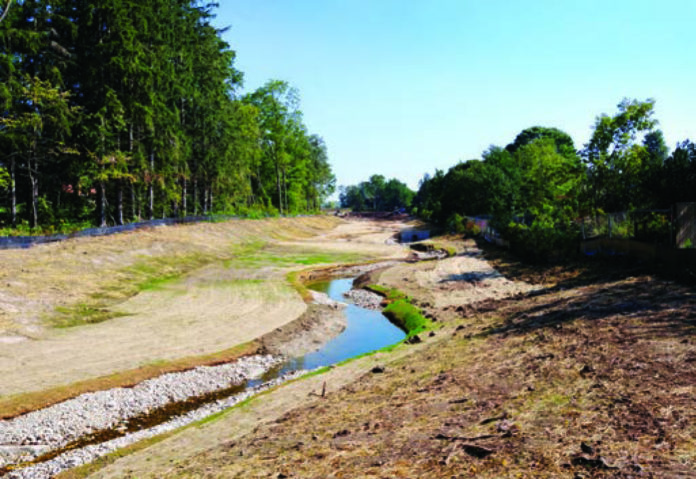CHALLENGES OF EROSION AND SEDIMENT CONTROL
FOR WATERCOURSE PROJECTS
By Heather Amirault, P.E.
The traditional role of erosion and sediment control (ESC) is to keep sediment from construction sites, with a particular emphasis on keeping sediment out of natural areas. It is especially important to keep sediment out of sensitive natural areas like watercourses and creeks. However, what happens when your construction site is a sensitive natural area? What about when your goal is to complete a project in a watercourse? Or when your project is a watercourse realignment or restoration?
Stream projects in Canada are typically initiated through the need to protect infrastructure. Examples include bank stabilization to protect a trail or pipeline, or channel realignment to accommodate a culvert extension or new road alignment. Once a project begins, the main regulatory influence is the Fisheries Act, which guides work in and near fish habitat and has a goal of preventing “harmful alteration, disruption or destruction of fish habitat.” Harm could include changing the water flow, reducing the amount of wetted area habitat or depositing harmful substances in a watercourse or waterbody. Under the Fisheries Act, sediment deposited in a watercourse is considered a harmful substance.
In some jurisdictions and/or during emergency response, regulatory agencies will allow “in-water work,” which is permission for a contractor to complete restoration works in live flow (i.e., excavators working right in the creek). The capacity of the watercourse to absorb a certain amount of construction-generated sediment is relied on during these in-water works. The ability to work rapidly while seeing the precise impact of each placed or formed feature is considered to be enough of a benefit to outweigh the cons of temporary construction sediment releases on the downstream habitat. In Canada, due to the focus on preventing harm to fish habitats, permission for in-water work is rarely given. Therefore, those managing Canadian restoration projects typically have to put a lot of thought and consideration into how to manage water and flows during construction. This consideration is necessary because managing water and flows is directly related to managing sediment, and therefore directly related to protecting aquatic ecosystems downstream of your project.
So, how do you do work in a watercourse without getting wet? How do you do work in a creek without changing the flows and affecting fish habitat downstream? You can’t just turn off the water. Water needs to continue downstream so fish habitats don’t dry out and leave fish stranded. It’s also not enough to just install some silt fence or a temporary sediment basin. The traditional land based ESC measures are typically not effective in water bodies. The usual regulatory requirement for working in a watercourse is that construction must take place “in the dry,” meaning the construction site must be isolated from creek flows. Working in the dry keeps watercourse flows separated from the construction area, limiting construction impacts on water quality. But how do you keep flows separate from your construction area when your construction area is a watercourse?
One way of looking at the problem is to think like a traffic engineer doing highway construction on a major highway. You can’t just close a major highway for a few months to get the work done, you have to keep the traffic (in this case, water) moving. On a highway project, you can use techniques like reducing lanes and providing detours. The equivalent of a lane reduction for a watercourse project would be to use a flume or pipe to move flows through the site, isolating flows from the rest of the worksite. The equivalent for a detour would be to dam and pump the flows around the site or to create a diversion channel. Sometimes new roads are built away from existing roads, and construction only disturbs existing traffic patterns at either end of the new road segment where it gets connected to the existing road network. In watercourse restoration work, building outside the existing channel footprint is known as offline construction. Offline construction keeps the new channel alignment far enough away from the existing channel alignment that flows can continue business as usual through the old channel until the moment comes to flip flows into the newly constructed channel. When only completing work on one side of a channel, turbidity curtains may provide adequate separation of the turbid construction waters from the clean flows in the rest of the watercourse.
Sometimes highway construction strategies involve closing entire highways overnight when traffic volumes are lowest. Complete closure won’t work for creeks. You will still need a detour. The closest equivalent would be completing the work in the lowest flow season, which is typically mid-summer in most of Canada. Timing the work around low-flow periods means you don’t have to have a system that must constantly manage or divert high flows from spring runoff or large fall storms. But what about large rain events or floods resulting in higher flows than the site isolation system can handle?
As discussed, managing the instream flow is a critical part of ESC on a watercourse project. However, we can’t stop at just managing these typical instream flows. The water on creek project sites comes not only from the upstream channel but also from the sky and overland. Additionally, flows within the watercourse are not constant, particularly in urban settings where instream flows are very responsive to precipitation events. Therefore, not only must we protect the watercourse by keeping instream flows separated from the construction area, but we must also keep the watercourse construction area protected from erosion and sedimentation.
Everyone has seen a newly graded site with fresh topsoil exposed. The site is vulnerable to erosion until vegetation is established. Watercourse sites have this same vulnerability but are at higher risk due to the chance of flooding. Leaving exposed soils on the valley walls, floodplain and channel banks is typically not an option as you are almost guaranteed to have erosive flows move through your work area at some point during construction or soon afterward. To reduce the exposure to flood risks during construction, it is typical to proceed by working on small sections of the new channel. This construction sequencing limits the amount of exposed and disturbed channel between the newly constructed (stable) section and the existing undisturbed section of the channel. In this way, the small, exposed disturbance area can be quickly stabilized with temporary rock protection or matting in preparation for a large flow.
Large flows can be anticipated by monitoring predicted precipitation in the weather forecast. Ultimately, as with any other site with exposed soils, the best thing you can do for a watercourse project site is to stabilize the soil with vegetation cover. Unfortunately, the vegetative cover is not instantly available, therefore interim measures are included to keep the site stable until the channel bank and floodplain vegetation becomes established.
Some of the stabilization measures commonly applied at watercourse sites include coir-wrapped soil at banks and biodegradable erosion control blankets on floodplain and valley walls. Beyond these surface measures, the design of channel and valley forms can be used to reduce erosion potential. A channel set within a low floodplain can be designed to spread high flows out over the floodplain. This connection to the floodplain reduces the shear stress and erosion potential from high flows and floods, promoting stability within the channel and valley.
The long-term stability of a creek site relies not only on the channel and valley form, but also on the successful establishment of vegetation. When developing a naturalization planting plan for a watercourse project, we consider the use of native tree and shrub species that don’t mind having wet feet; species suited to growing near water that can handle being flooded occasionally. The seed mixes selected for application over the floodplain and valley walls usually include a cover crop mixed in with a perennial native seed mix. In this way, the cover crop can grow quickly and provide some stability for the slower growing native perennials. Planting plans will often include the use of live stakes along watercourse banks. This form of shrub planting is inexpensive, easy to install and provides the long-term benefit of dense riparian growth with strong roots to stabilize the creek banks.
When your goal is to complete a project in a watercourse, not only do you need to control the flows within your workspace, but you also need to be aware of surface runoff and potential high flows that can overwhelm your water management strategy. Planning the ESC approach early in the project is important. Using appropriate diversion techniques and stabilization measures can allow the successful construction of your creek project while protecting sensitive aquatic habitat. The vegetation planting plan is a critical component of the ESC plan, which will provide for long-term erosion protection, overall site stability and habitat enhancement at
the creek site. Working in creeks and streams requires an extra level of planning and consideration when developing and implementing an ESC plan.
About the Expert
Heather Amirault, P.E., is a water resources engineer at Stantec Consulting Ltd. She specializes in the areas of stream rehabilitation using natural channel design and geomorphic principles. Amirault has worked on stream restoration and erosion control projects across Canada.
